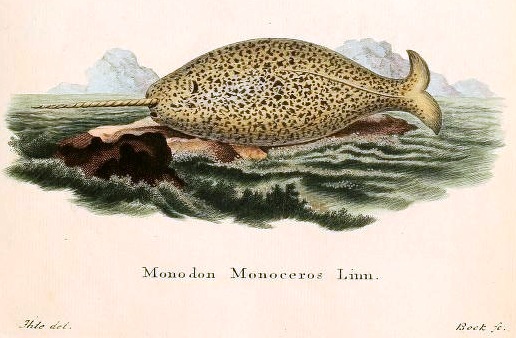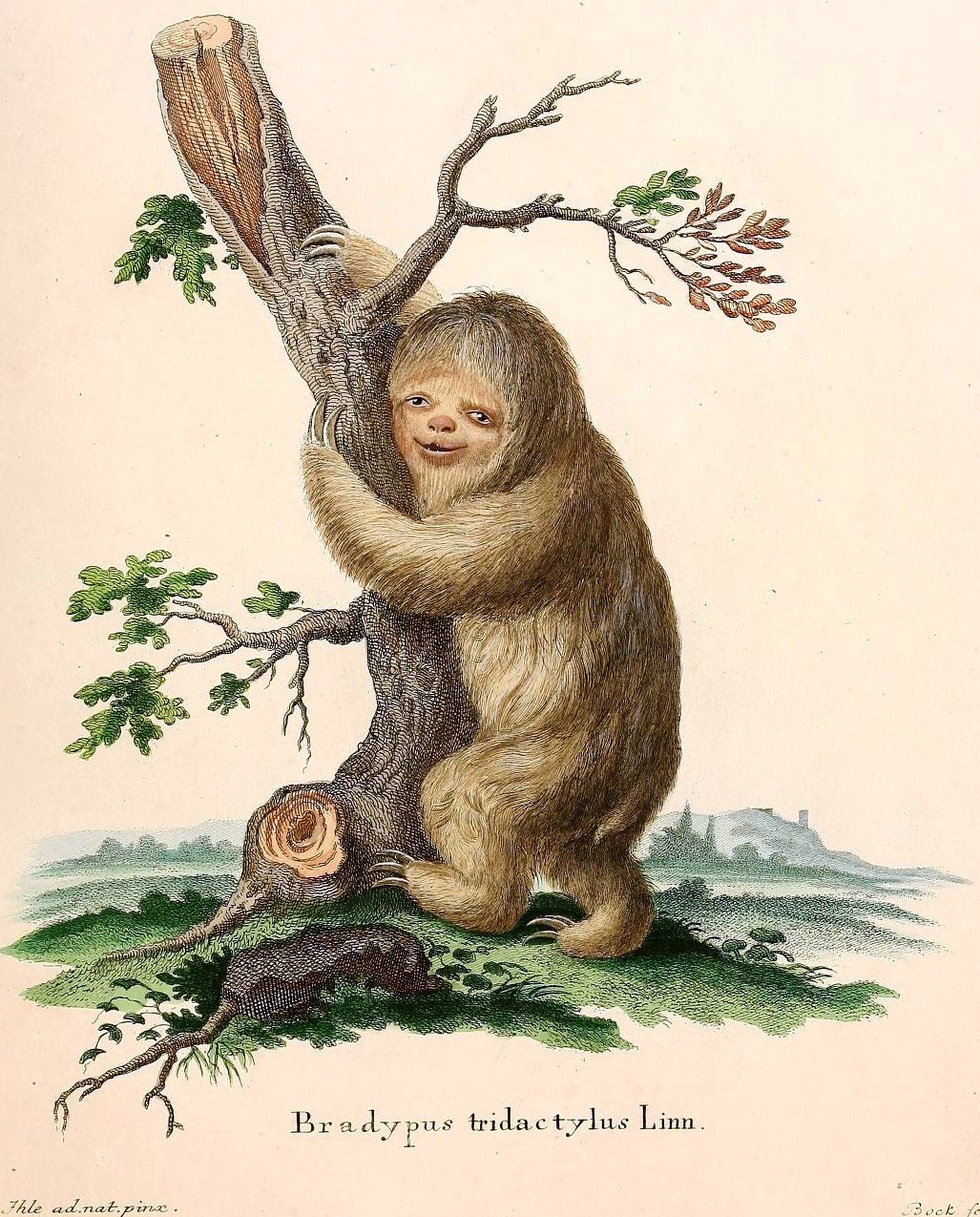The Narwhal, the Ocean’s One-toothed Wonder
Queen Elizabeth I was rumored to have purchased a narwhal tusk for 10,000 pounds — in the 16th century this was roughly the price of a castle.
 View more of Von Schreber’s mammals on Flickr.
View more of Von Schreber’s mammals on Flickr.
The mysterious narwhal and its famed “unicorn horn” have long captured the popular imagination of man. In the middle ages, the tooth of a narwhal would fetch ten times its weight in gold because it was thought to carry magical and medicinal powers. It wasn’t until 1871, that Darwin conjectured in The Descent of Man, and Selection in relation to Sex that the tooth’s function was actually a Secondary Sexual Characteristic that determined things like social rank, mate selection and dominance in narwhal pods which, usually consist of groups of fifteen to thirty individuals.
The tusk has been the subject of much speculation over the centuries yet, we are still unraveling its mysteries. Who was right? Queen Elizabeth I and her medieval contemporaries or Darwin? I’m sure that many of you are betting on Darwin however, modern research has found that the tusk may actually have an entirely different and previously unimagined function.
 |
| See any human-like qualities? |
To get a better idea of what the Narwhal looks like, we reference one of our absolute favorite illustrations of the narwhal here at BHL (pictured above). This image appears in Johann Christian Daniel Von Schreber’s Mammals in Illustration from Nature auf deutsch: Die Sugthiere in Abbildungen nach der Natur (1774), also our pick for Book of the Week.
The narwhal is included in Von Schreber’s majestic collection of over 700+ mammals; he commissioned artists to create the plates from his own scientific descriptions of each species. Many of the mammals that appear in the nine volume set were named for the very first time using Linnaean binomial nomenclature.
Because all of the illustrations in the book are drawn from Von Schreber’s written descriptions rather than from observation, you will notice that there is an element of the fantastical in the expressions of the animals. The mammals have distinctly anthropomorphic features, inviting the viewer into their world and giving us the sense that we aren’t so different from each other after all. The drawings are so unique that they have garnered much attention in art circles. Reprints of various plates can be found on art merchant websites and even on Ebay selling for hundreds of dollars.
The art world has dubbed the collection of plates “Schreber’s Fantastic Beasts.” Luckily, we no longer need to spend hundreds of dollars to view these beasts. The entire beautiful set is now online, digitized from the rare book room at the Ernst Mayr Library at Harvard University.
 |
| Johann Christian Daniel Von Schreber |
Von Schreber, like his beasts, was a fantastic man in his own right. It only seems natural that he would be one of Linnaeus’ many students who would go on to achieve success yet, still remain devout to his teacher for the duration of his life. The correspondence between Von Schreber and Linnaeus was voluminous and it too has been digitized and made available for free by the Linnaean Correspondence Project.
If you can read Latin, its a highly recommended resource! Von Schreber studied medicine, theology and the natural sciences at Uppsala and Halle. It was at this time that he came under the tutelage of Linnaeus. He went on to become the director of the Erlangen Botanical Garden in 1773, a member of the Royal Swedish Academy of Sciences in 1787 and in 1791, he was knighted. Not bad, Von Schreber! He also served as editor to Linnaeus’ 8th edition of Genera Plantarum. Von Schreber even has a type of feather-moss named after him, Pleurozium schreberi. But we digress, let’s get back to the narwhal.
The Narwhal: Why do we know so little, when we are so fascinated by this creature?
 |
| The beluga whale, the other member of Monotinidae family |
All that we have left of Schreber’s thoughts about the narwhal are from the minute descriptions he makes in his text describing the Monodon monoceros yet, he must have been stewed in a culture that was still hanging on to the idea that the narwhal tusk possessed magical powers. We wonder if Von Schreber clung to any of these superstitions himself?
One-hundred years later, Darwin refuted the idea of this type of magical nonsense. However, it wouldn’t be until 2005, that Harvard researchers would begin to unravel the mystery behind this one-toothed wonder. The main reason that so little is known about the narwhal and its behavior is because most of them die in captivity, which has made it very difficult to study them.
Unlike the narwhal’s relative, the beluga whale, both being the only extent members of the Monotinidae family, the narwhal is an incredibly shy creature preferring to stay away from your local Marine World. However with a tusk fossil in-hand, dental researchers have been able to gain new insights and get to the root of this toothy mystery:
“Dental experts put the tusk under an electron microscope and found new subtleties of dental anatomy…” making a “startling discovery: the tusk, it turns out, forms a sensory organ of exceptional size and sensitivity, making the living appendage one of the planet’s most remarkable, and one that in some ways outdoes its own mythology.”–Broad, 2005, New York Times
| David Constantine, Mika Gröndahl/The New York Times |
It seems that Queen Elizabeth I and Darwin were both slightly off-base… the Narwhal’s tooth is an incredible appendage but, its function is neither magical nor strictly used in sexual selection. Rather, who would have guessed that the spiraling tooth would actually be a highly sophisticated sensory organ, giving its owner unique insight into the temperature, pressure and gradients of the ocean? The discovery opens up a whole host of new and unanswered questions. It is no wonder that researchers are clambering to know more.
Clinical instructor at Harvard University’s School of Dental Medicine and principal investigator of the Narwhal Tooth Expedition and Research Investigation, Martin Nweeia remarks after his first Narwhal siting:
It’s one of the few times when the reality is more incredible than the fable – I have more difficulty believing a whale has a tusk like this than I do a unicorn.”
Here, here Martin! The Narwhal truly is a “fantastic beast” and human interest in the species will only continue to grow over time.
Don’t forget that tomorrow is World Oceans Day!
Lastly, don’t forget that tomorrow pack’s a double whammy for ocean conservation efforts, celebrations and observances: not only has Obama declared that June be National Oceans Month in the United States but, June 8th also marks World Oceans Day.
Of course, these celebrations should include the beloved Narwhal, one of the most unique creatures the ocean has to offer. People all around the world are celebrating in creative ways. If you are interested in participating don’t forget to check the world event calendar and remember to respect, care for, and love the ocean. After all, we owe the air that we breathe to it and so much more!





Leave a Comment